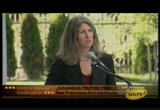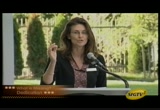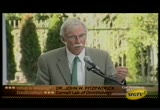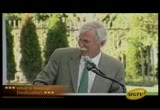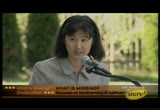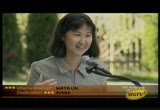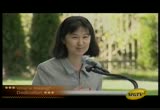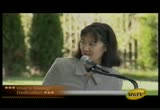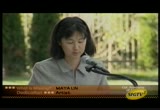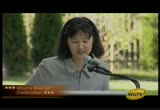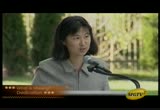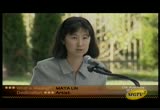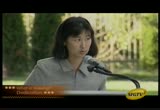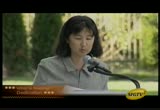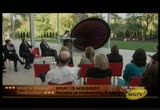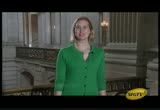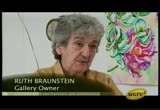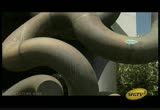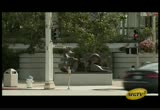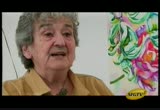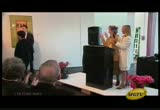tv [untitled] September 3, 2010 4:30pm-5:00pm PST
5:30 pm
we hear things that put us in a particular place. we live in a world that we have to try to address even though it might seem too big for us to grasp in one class, gesture, or action. -- too big for us to grasp in one glass. this is an amazing piece. an amazing solution. an amazing challenge dealing with the ambitions to talk about questions of sustainability. to look at these preservation efforts. to do it in a way that even a child can engage in. the we think about how the children coming to the academy will interact with it. as a former arts commissioner and as a citizen of san francisco, we want to celebrate
5:31 pm
this season and to thank maya for the pleasure of working with her. thank you. [applause] >> it is a delight to introduce the director of the academy center for biodiversity research. [applause] >> thank you for the opportunity to share a few words about what it is like from the perspective of the academy of sciences. i had been one of many sources of information of the sciences is that has contributed to the extraordinary journey of knowledge about biodiversity. on behalf of my colleagues, i can tell you that we are thrilled to have a portal to the
5:32 pm
earth on our east terrace. what is missing is a subject that lies at the very core of the research of the institution. we are about documented and describing the diversity of life and this portal allows you to experience that directly. our research centers about going to the far corners of the world which we have been doing for 150 years. we can offer a perspective on life which is our foundation and knowledge. in short, academy sciences have been for well over a century [inaudible] we will feel the pulse. this transforms the idea of a dry list of many species that
5:33 pm
have gone extinct into an emotional experience of how small our fish has become, how few great migrations there are. how great is the darkness of our night sky. we emerge recognizing that we are on a trajectory and what is missing allows us to understand what the scope of that trajectory is. if we look just from what is around us, the scope does not look as deep. what we're looking at takes us back to how things used to be and we can recognize how deep that trajectory is. by reminding us of what it has lost, we can see much more clearly where we are headed. the academy welcomes you to enter the portal that maya has created, to feel the connections
5:34 pm
that have been made right here between past and present and future. to ask if you are shifting the direction we're headed. thank you very much. [applause] >> it is my pleasure to introduce john fitzpatrick. >> thank you so much. i think you are one speaker away from the main attraction so i promise to be brief but i want to say first of all congratulations to the california academy of sciences, the board, and the staff. congratulations to the city of san francisco and the arts commission.
5:35 pm
congratulations to maya for bringing all of those thoughts and images and connections that this project has gone through to fruition here in this megaphone. it just occurred to me sitting right over there that endangered species and extinct species and threatened ecosystems and migrations around the world that are in peril of being lost because of the human endeavor, they all had a megaphone at this point. congratulations to the city of chicago for having this. what occurred to me is that this is pointed straight at the north american continent. it is broadcasting to the citizens of the entire country and it is carried out all over the world. what we have in store, we hope, the reversal that has begun over
5:36 pm
the past month. when the lab is a place that in many respects was predisposed to be adapted to the visit and first phone call. we have for almost 100 years used charismatic creatures not just to understand how nature works. after all, birds are extremely valuable tools. they are something much more, they communicate by sound, color. they are natures best spokespersons to us humans to think about how nature works and to think about our relationship with it. this has been made part of our mission as well, not just to
5:37 pm
understand how species are but to use them to attract human beings to the idea that we have a relationship with this and we responsible. when we got the call from maya about doing the piece, it was a real treat. it was a no-brainer to say that we have to work with you. we have the world's largest repository of sound recordings. we had a very large growing library. it has been a terrific treat to work with maya and to see a small bit of how this creative
5:38 pm
mind works. we have long thought to unite science with art. all of the creatures in movements and patterns and places are related. when she first visited to the loud and met with the people who talk about ideas, i can tell you by the end of that meeting, i went back to new york city and i had a committee of people going [inaudible] how can this come together? this is the beginning of a multi institution effort to get everyone in the world to be thinking about our responsibilities and opportunities using the personal
5:39 pm
experience that one gets up close and personal with these beautiful creatures. what a treat. congratulations. >> thank you. with the light, pleasure and a sense of getting this -- with delight and pleasure, i introduce maya lynn. >> thank you. i am curious about this because i've heard that if we don't get to this quickly, there will be a disco beat. the academy has been so helpful. to this san francisco parts commission, president johnson,
5:40 pm
the commissioners, thank you so much for your unwavering work. it is crazy that we ended up doing two projects. thank you, the face you have in this project, we could pull this off and this is pretty amazing. without your support and respect for the experimentation, this would not have happened. thank you. to the board and the scientists and staff, thank you for all the questions that you ask, all the answers that you sent me. i was too worried about the landscape and the fact that in my work -- i love science but i think more like an artist. thank you for humouring me.
5:41 pm
you were great, you send me so much material. we went through it but maybe in a random way. i think that that is the duty between form a the relationship between science and art and i would probably say that you have been exposed more than you want to an artist process. -- i think that it is the duty between form and relationship. i have been very much informed by science. i think that we sent all of these over to the experts because there's nothing that i want to say here that is not grounded and very much in fact. in fact, sometimes we were stripping back some of the attacks that were sent because they were too emotional. -- some of the texts that we
5:42 pm
were sent because they were too emotional. if i can just present the history and try to pull back and maybe change the tone. if i come off too strong, you might turn away and lose interest. this is a fine line that i have been playing. i want to thank scott and his team who has helped installing with the landscaped and with the tone and all of the crazy iterations that i try to explore out here. thank you for humouring me. in the next few years, if we explored many different iterations. we want you to look at it and see an image. i know that you will really be taking care of it and now.
5:43 pm
last night, being out here, checking the humidity inside. we were a the high end today it is stabilized. i know that i leave the cone in incredibly good hands. thank you. we have done in two major art works for the price of one. of course, if you had not come through it would have been impossible for us to do this. >> johjohn fitzpatrick and the amazing staff at cornell. the amount of film that the ornithology lap donated. -- lab donated. i cannot thank you announced. i think that the fact that we are a very visual creature, you will not see the animal first, you will hear it. you will read what is and then
5:44 pm
we will let you see it. we tend to be incredibly visual. maybe you will pay close attention to some of the sounds. sounds gives us a way of experiencing a place, not just this but places. i would also like to acknowledge incredibly generous support of national geographic archives, the bbc, and some may be in -- and some amazing independent filmmakers. the american museum of natural
5:45 pm
history, wildlife conservation society, the world wildlife fund, the nature conservancy, freedom to roam. people that have donated film and media other than the core. that camel protection foundation, independent filmmakers. nick sherman, mark shelley, richard ellis, michael hughes, elizabeth colbert, simon
5:46 pm
winchester. i have been calling a lot of people and asking a lot of questions. thank you to my studio assistance. in sound and media, we have carolyn chadwick, raymond chavez, alex chadwick. my media coordinator, luc d ubious. they've given us a much of their time and brilliance to work with us to help in the final character of the media and also pentagram and management.
5:47 pm
i have to think what wall of foundries -- i have to thank walal walla foundries. what is missing? it begins with an accounting of what we are losing as we watch. in terms of species and habitat loss and i hope it provokes more a sense of wonder at what this planet is capable of and still could return to. this is a beginning. let's imagine this as a portal. we have begun to think of this as listening to the earth.
5:48 pm
me will be able to connect to the president. we see all the things that are being accomplished. we can also see into the future and by 2000 12th, we will start with the clean paint for the future. -- and by 2012, we will start with the green plan for the future. we start with the past and a new idea of what a memorial can be. we launched here with what is missing. in two days, we are launching a traveling exhibit in beijing at the beijing arts center. we were rebuilding those and they never translated -- we have
5:49 pm
translated into chinese more. many of them focused on animals that will go extinct if we can -- if people continue to purchase traditional chinese medicine that uses animals. we want to focus on the critical habitats that they need to survive and on the issues that you might not even realize that are disappearing. how can we protect it if we don't even see it as existing food for many of the songbirds we knew as children -- how can be protected if we don't see it as existing? many of the songbirds that we knew as children are disappearing. we will start this thing up in a second. or will read to you the beginning intro, every 20
5:50 pm
minutes the peace repeats with the same intro and the same conclusion with a different sound and a different background. it starts with what is missing. pieces that have gone extinct, species that will go extinct in our lifetime, the species that we will never know. on average, any 20 minutes, a species will disappear from the planet. in the time that it takes you to view this film, when species will vanish. what is missing, the ability of animals to migrate freely. the ability of animals to hear and see under water.
5:51 pm
air, mountaintops, rivers flowing freely to the sea, the visibility of the stars at night. imagine in map that shows our needs with the needs of the planet. can we imagine the range in the light? can we imagine sharing the planet? thank you. [applause] but we have is a set intro, a sad conclusion, and then we will continue to build more scenes. we have about 50 made. -- what we have is a scenario, a conclusion. maybe you can come here and visit and you will hear different things.
5:52 pm
5:53 pm
>> welcome to culture wire. did you know the city of san francisco has an art collection consisting of 3500 objects? the collection ranges from painting and public buildings to murals, and from bronze busts in city halls, to cite specific structures. at this time, many of the large works are in desperate need of repair, and a long-term innovative solution is needed to make sure these public treasures will be cared for. >> the story of the arts commission program begins with ruth fromstein. 2010 marks her 50th year as an art dealer.
5:54 pm
at the helm of the county, she had represented some of the most notable of bay area artists, and continues to look for new talent. >> the artists that i represent, what do i choose them, if asked to do with a background of what the gallery is about. i love the idea of finding new guys and watching them grow. it is the old fashioned way of having a nunnery, which is having a stable. what you have is loyalty to them, artists are loyal to you. the philosophy behind that, my philosophy, has not changed since i started 49 years ago. i take care of you and you take care of me. it has been that way ever since. >> ruth represents the estate
5:55 pm
of the world renowned sculptor peter focused. in 1971, he created and the love the untitled public work cited at seventh and bryant. like many other public works of art, this is in need of repair. ruth began conversations with the director of cultural affairs, a andart care was born. >> we look at all of the local pieces and decided which one needed the most repair, to bring it back to where it was before. that is what i am after. if you drive by right now, you cannot see it coming down seventh street. you can only see it as you come up to it. >> one's culture outside of the
5:56 pm
hall of justice was one of the first pieces commissioned after the 1969 ordinance. it is significant that we are planning to treat it as part of the art care program. the program intends to take care of the bronze sculpture located in very park, a monument to the korean community of san francisco. it has been in the park for over 20 years, has become a bit of a magnet for vandalism. we are also looking at several sculptures from henry more, one in front of the symphony building. we are also looking at yen and yang, a much loved peace -- piece. but the team has been damaged over time, so we need to treat -- patina has been damaged over time, so we need to treat it.
5:57 pm
>> roof and was given a lifetime award for her contributions to and influence over the bay area artist community. >> the lifetime achievement award -- it is embarrassing to me but i have to learn to accept it. this is the way it is. also, everybody here is good things happening about them after they are dead. i have the opportunity to see this happen while i am still lives. i look at this award as an opportunity for me to find a place for my craft and keep the art program going. >> the director of the program address the crowd and ask for each member to consider donating funds to help save some of san francisco's most important neighborhood landmarks. >> as one of san francisco's
5:58 pm
living treasures, we respect you and, frankly, we are in off -- awe of your 50 years of tireless effort as an early art on from for north. >> i would like to be perhaps the first donation to our care and present you with a check to get the ball rolling. >> because i know that the arts commission is very sincere about this, i'm going to make a personal commitment of $10,000. [applause] >> what is significant about the program is the way it is set out allows us to treat the artworks that have the most need, the ones that our conservative have pointed out as the most vulnerable as opposed to ones that might be the most popular were the most miserable -- the most visible. >> it is an opportunity for the public to get involved with these art works located in their backyard and ultimately belong to them. >> i want to do something for
5:59 pm
the community, just giving back what the community has done for me. it is corny to say, but it is true. it really is what it is. that i would be able to see more pieces cleanup. >>" will check back in the future and see the fruits of conservation and revitalization efforts. if you would find out more or donate to the art carethe donate to the art carethe artsfartcommission.org.
79 Views
IN COLLECTIONS
SFGTV2: San Francisco Government Television Television Archive
Television Archive  Television Archive News Search Service
Television Archive News Search Service 
Uploaded by TV Archive on

 Live Music Archive
Live Music Archive Librivox Free Audio
Librivox Free Audio Metropolitan Museum
Metropolitan Museum Cleveland Museum of Art
Cleveland Museum of Art Internet Arcade
Internet Arcade Console Living Room
Console Living Room Books to Borrow
Books to Borrow Open Library
Open Library TV News
TV News Understanding 9/11
Understanding 9/11